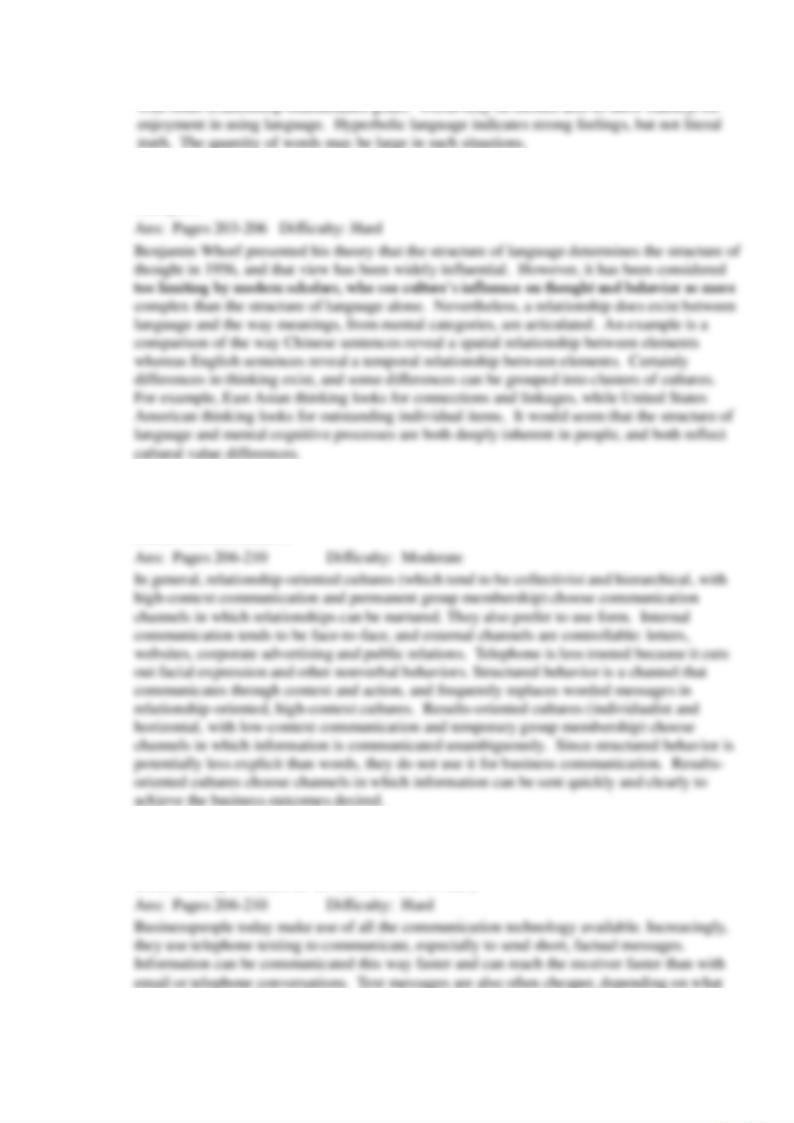
CHAPTER 5
ORGANIZING MESSAGES TO OTHER CULTURES
Test Bank
Essay Questions
1. Discuss the issue of culture in the conventional communication model.
2. Describe the direct plan for organizing messages and discuss the cultural reasons for
preference (or distaste) for it in at least two cultures.
3. Explain what the indirect plan is and discuss reasons for its choice, with reference to cultural
dimensions of at least two cultures.

unwelcome news. The indirect plan, with its attention to relationship, buffers bad news and
4. Discuss persuasion in messages from at least two cultures from among these three different
regions: Western Europe, East Asia, and Arab cultures
5. Discuss storytelling, analogy, and bargaining discourses as ways to communicate about
problems.
6. Choose one low-context culture and one high-context culture and discuss the way words are
regarded in the two cultures, taking into account
a) trust in words to communicate meaning
b) choice of words
c) calculated impact of words.

with other relationship-maintenance goals. Words may be chosen also to show fluency, for
7. The way a language is structured seems related to the structure of thought. Discuss, using
examples.
8. "Choosing the right channel is a communication skill." Discuss internal and external channels,
oral channels, and structured behavior channels in relation to relationship-oriented versus
results-oriented cultures.
9. Technological developments have changed the way businesspeople use communication
channels. Discuss the effect of culture on business communication in telephone text messages,
social media posts (such as on Facebook and Twitter).

part of the world you are in. Social media such as Facebook and Twitter are being used by
10. Formal and hierarchical messages often go together; informal and horizontal messages often to
together. Explain, using examples from specific cultures.
11. The idea is what travels from sender to receiver.
12. The place for culture in the communication model is at the decoding stage, to make the
model complete.
13. The why in business communication refers to the purpose for which a message is written.
Asn: True Page 175 Difficulty: Moderate
15. Channel choice (email, face-to-face, telephone) for communication is not affected by culture.
16. Clarity and conciseness are important characteristics of business messages in any culture.
17. Indirect plan organization means putting the main message in the first sentence.
18. Developing a context for a business message is important to most Asian communicators.

19. Low-context cultures generally use indirect plan for persuasive messages.
20. Logic based on facts is the only way people in collectivist cultures are persuaded.
21. When communicating about problems, members of high-context cultures may refer to past
experiences for assurance of correct solutions.
22. Saying "no" is often done with delay and indirectness in low-context cultures.
23. One way to communicate about a solution to a problem is through narrative.
24. Behavior, such as the way a cup of coffee is offered, cannot communicate as effectively as
words.
25. Japanese communicators value "hearing one and understanding ten."
26. Arabic speakers and English speakers both prefer elaborate phrases and using large numbers of
words.
27. Choice of channel may be culturally based--for instance, preferring written memos over oral
communication.
28. Communication between international parties is always by memo.
29. Framing is explaining a context of a message before delivering it.
30. Virtually every aspect of written and oral communication is affected by the cultural priorities
of the communicators.

31. The communication model shows
a. a sender transmits meaning through a channel to a receiver
b. the idea travels through the channel to the receiver
c. encoding and decoding takes place with noise
d. the message triggers decoding in the mind of the receiver who assigns meaning to it
32. Culture belongs in the communication model
a. at the encoding by the sender
b. at the channel
c. at the decoder by the receiver
d. in every part of the communication process
33. Purposeful business communication involves the task of
a. costing
b. financing
c. refusing
d. pondering
34. Direct-plan messages
a. get to the main point quickly
b. are preferred by members of high-context cultures
c. always insult those who prefer indirect plan
d. put the main message after the explanations
35. Indirect plan is
a. preferred by cultures that value individual responsibility--both credit and blame
b. preferred by cultures that communicate about results
c. preferred by low-context cultures for persuasion
d. preferred by high-context cultures only for persuasion
36. Unwelcome messages

a. are easy for people in low-context cultures to communicate
b. are usually organized in an indirect plan by members of high-context cultures
c. require someone to be blamed, since the words are not impersonal
d. must be in words, in high-context cultures, to be understood
37. When it comes to saying "no"
a. members of some high-context cultures are not concerned about the loss of face of
those being refused
b. members of some high-context cultures have a hard time actually saying "no"
c. members of low-context cultures prefer to say "no" quickly
d. members of low-context cultures have great concern for loss of face of the person
saying "no"
38. The book discusses all the following ways to communication about a solution to a problem
EXCEPT:
a. analogy
b. syllogistic reasoning
c. bargaining
d. listing
39. The role of words
a. is not important in Japanese culture, in which words alone are not trusted
b. is not important in Arabic cultures, in which words alone are not trusted
c. is not important in German culture, in which words alone are not trusted
d. is not important in New Zealand culture, in which words alone are not trusted
.
40. There is a suggested relationship between language and the way people think. Which of the
following statements about the relationship is NOT true?
a. it was explored in the late 1950s by Benjamin Whorf
b. it proposes that the categories by which we understand the world are related to the way
we organize language
c. it claims that native speakers of the same language think in similar patterns
d. it proves that speakers of different languages think alike